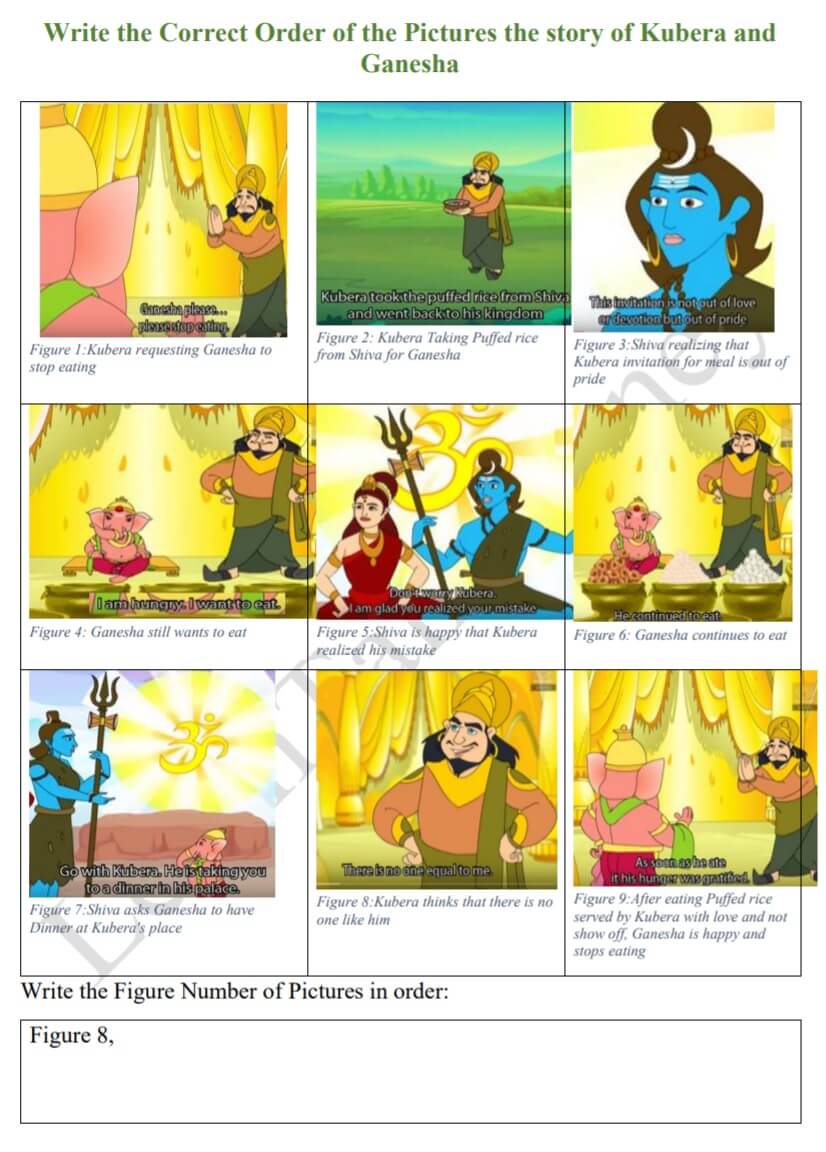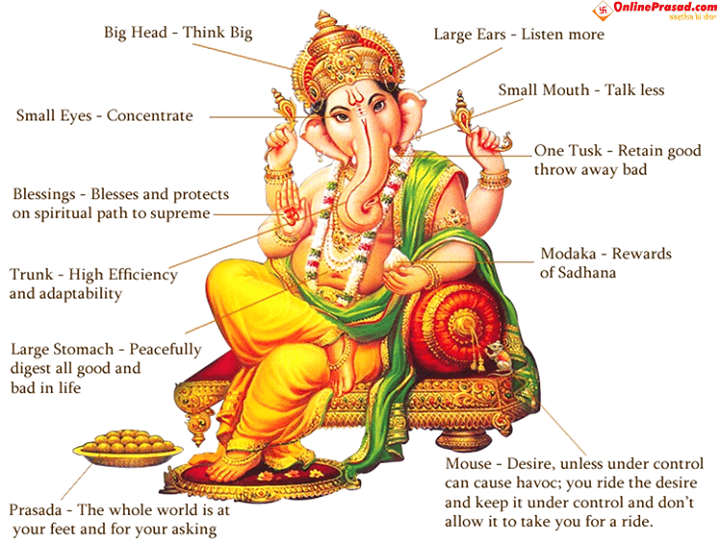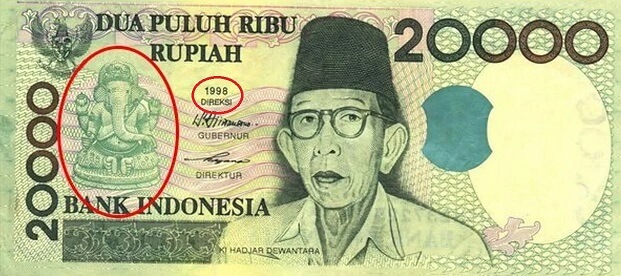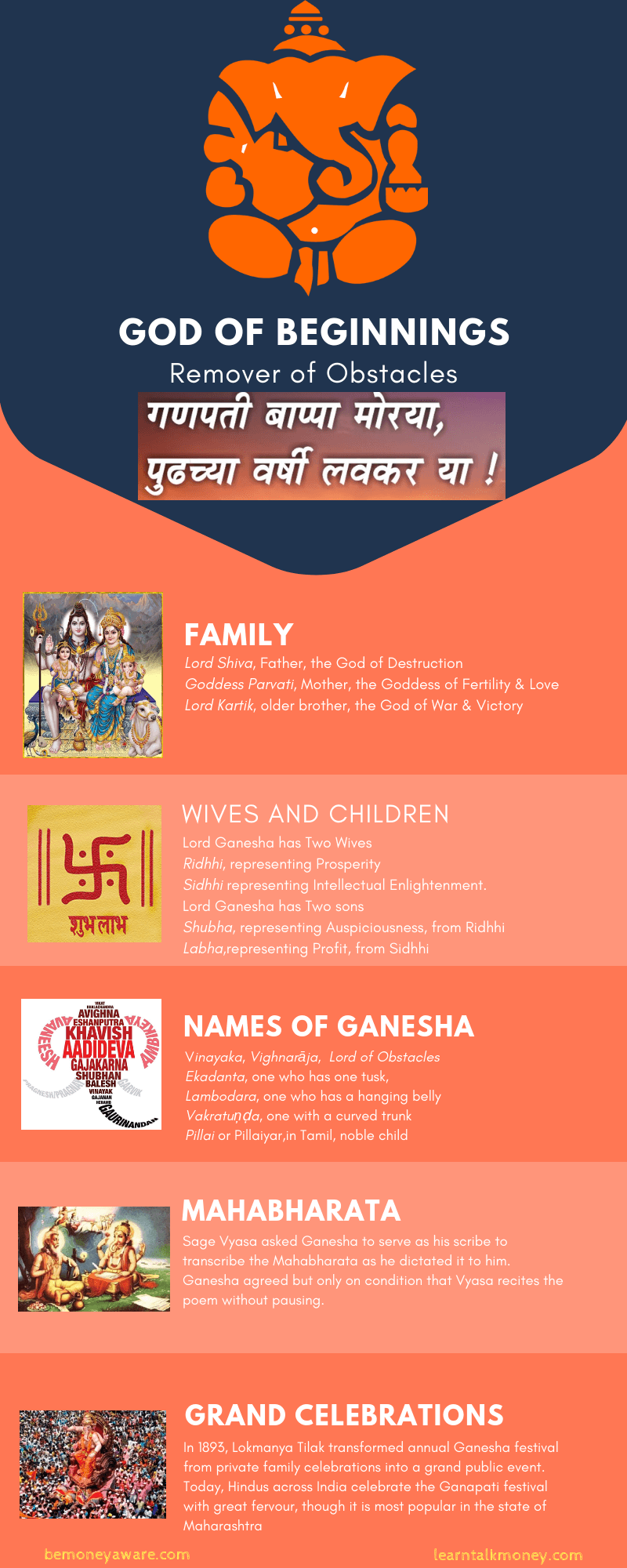Lord Ganesha is considered God of wisdom, intellect, success and prosperity. Goddess Lakshmi is the Goddess of fortune. Why are Lakshmi and Ganesha worshipped together? Why is Ganesha worshipped during Durga Pooja? How did Ganesha teach Kuber, the God of Wealth a lesson on humility? Also an infographic on Ganesha.
Table of Contents
Why are Lakshmi and Ganesha worshipped together?
What is wealth without prosperity? What is money without the wisdom to use it properly? Will all the material gains in the world be permanent without intelligence? Can anybody attain any great prosperity without removing the obstacles on the path?
Qualities of Goddess Lakshmi and Ganesha are complimentary so our custom requires us to worship both of them together. This reminds us that we don’t have to aim only for material wealth but also have to aim for prudence and wisdom.
Lord Ganesh who is the lord of people (Gana) removes various hurdles so that his devotees progress towards their aim (Lakshya); material prosperity (Labha) and spiritual successes.
Story of Lakshmi adopting Ganesha
According to the scriptures, once Goddess Lakshmi grew very arrogant about Her wealth and powers. While having a conversation with her husband, Lord Vishnu, She kept praising Herself that She is the only one worthy of worship. She is the one who bestows everyone with money and wealth.
Lord Vishnu said that in spite of having all the qualities, a woman remains incomplete if she does not bear children. Motherhood is the ultimate joy that a woman can experience and since Lakshmi did not have children, She could not be deemed complete. On hearing this Goddess Lakshmi was extremely disappointed.
With a heavy heart, Goddess Lakshmi went to Goddess Parvati to seek help. Since Parvati had two sons, She requested the Goddess to let her adopt one of her sons to experience the joy of motherhood.
Parvati was reluctant to let Lakshmi adopt because it was known that Lakshmi does not stay in one place for long. So, she asked Lakshmi how she will take care of her son. So Parvati gave Lord Ganesha to Goddess Lakshmi. Goddess Lakshmi became very happy and said to Goddess Parvati, “From today onwards I’m giving my all accomplishments, luxury and prosperity to my son Ganesha. Those worshipping Lakshmi for wealth would first have to worship Ganesha to seek Her blessings. Those who will worship Lakshmi without Ganesha will not be blessed by the Goddess”
The relationship between goddess Lakshmi and Lord Ganesha is a mother-son relationship. According to Hindu tradition, the husband should always stand at the right side of wife. Since Lord Ganesha is the adopted son of goddess Lakshmi, Lord Ganesha’s actual position is at the left side of Goddess Lakshmi.
Ganesha and Kubera
In Indian mythology, Kubera is the God of wealth & is known as Dhanpati. He is also the king of Yaksha’s, the guardians of Earth. As the God of wealth and material, his responsibilities are to distribute them while the responsibility of creating wealth is with Goddess Lakshmi.
The tale of Ganesha and Kubera teaches us one of the basic principles of life. It teaches us to remain humble and grounded even after we become wealthy because wealth only defines our financial status in society but not our character.
Kubera wanted to show off to the world how rich and hospitable he was. So he organized lavish parties and made sure everyone attended it. Though all the Devas came and appreciated Kubera’s palace and his hospitality, he was not satisfied. Only if I get Shiva and the Goddess to my house, would people praise me even more…When people realize that even the great God and the Goddess looked at my palace in awe, well people would respect me even more.!
Shiva and Parvati politely refused Kubera’s invitation saying they were busy. However, they told him that Ganesha would soon be returning home and that he would be quite hungry. So Kubera agreed to invite Ganesha to his palace alone.
Kubera left Kailash with Lord Ganesha and went to his palace. When Ganesha reached Kubera’s palace Kubera tried to show off his riches to Ganesha. But Ganesha demanded food as was promised to him by Kubera.
Kubera instructed his servants to bring food for Ganesha. Ganesha kept eating but Ganesha kept on demanding more and more and the food had to be replenished again and again.
When all the food in Kubera’s palace was finished and Ganesha was still asking, Kubera instructed for more food to be brought from the neighbouring villages. But Ganesha’s hunger was still not satisfied. Kuber pleaded that he couldn’t feed Ganesha anymore.
Ganesha was furious at Kubera and threatened to eat him up. Kubera was quite frightened and he ran to Kailash to seek help from Shiva and Parvati. Kubera begged them for forgiveness and apologized for his vanity and arrogance.
Lord Shiva explained that Kubera only wanted to show off his wealth and money to Ganesha. So Ganesha was not satisfied. Kubera should feed Ganesha with a pure heart and good intentions.
Lord Shiva gave some rice to Kubera and asked him to feed it to Ganesha with good intentions. W Ganesha did so and said that his hunger was satisfied. Lord Kubera thus learnt the importance of humility from Lord Ganesha.
You can see the video and discuss the activity with your children using the worksheet below.
For book(rs 200) and workbook(Rs 50) on Learning about Money, you can know more here.

Ganesha teaching Kubera value of Humility
Ganesha and Durga Pooja
During Durga pooja, Ganesha is celebrated with his Mother Durga and siblings Kartikeya( (God of war), Saraswati(goddess of knowledge and music) and Lakshmi(Goddess of wealth, prosperity). Durga Puja festival marks the battle of goddess Durga with the shape-shifting, deceptive and powerful buffalo demon Mahishasura, and her emerging victorious. Durga Puja or Durgotsava is an annual Hindu festival is popular in West Bengal, Bihar, Jharkhand, Odisha, Assam, Tripura, Bangladesh, and Nepal where it is called Dashain. The festival begins on the first day with Mahalaya, marking Durga’s advent in her battle against evil. The last four days, Saptami, Ashtami, Navami and Dashami, are celebrated with much gaiety and grandeur.
Durga Puja is also called Navaratri Puja in Gujarat, Uttar Pradesh, Punjab, Kerala, and Maharashtra, Kullu Dussehra in Kullu Valley, Himachal Pradesh, Mysore Dussehra in Mysore, Karnataka,Bommai Golu in Tamil Nadu and Bommala koluvu in Andhra Pradesh.
In 2019 Durga Puja Mahalaya is on 28 September and Dashmi on 8 Oct 2019
The festival epitomises the victory of good over evil and it also is in part a harvest festival that marks the goddess as the motherly power behind all of life and creation. The Durga Puja festival dates coincide with Vijayadashami (Dussehra) the victory of Rama is marked and effigies of demon Ravana are burnt instead.
Durga, also known as Shakti or Devi is one of the most popular goddesses among the Hindus. She has ten arms, rides on a lion, carries weapons and a lotus flower. She is an embodiment of feminine force (Shakti) and creative energy. She is the mother of Ganesha, Kartikeya, Saraswati and Lakshmi. She represents strength, morality, power and protection.
Goddess Lakshmi and Lord Ganesha are on the left side of Goddess Durga’s idol.
Goddess Saraswati and Lord Kariteya are on the right side of Durga’s idol. Lord Kartikeya, the son of Lord Shiva and Goddess Parvati, is also known Murugan or Subrahmanyan. Lord Kartikeya is shown mounted on a peacock.
Goddess Lakshmi is portrayed as standing on a lotus with her mount owl.
Goddess Saraswati is depicted holding a Veena with her mount swan,
Lord Ganesha is shown in a sitting posture with his mount mouse.

Durga Pooja
Why Durga goes to her parents home in Durga Puja
Uma, also known as Sati, was the beautiful daughter of Daksha, the king of the Himalayas, and Menaka. Uma was in love with Lord Shiva and she worshipped and prayed to him to make her his wife. Pleased with Uma’s devotion, Lord Shiva accepted to marry Uma or Sati. But Daksha did not want Uma to marry Lord Shiva who wore tiger skin and was bathed in ashes and roamed cemeteries. But an adamant Sati married Shiva.
When Lord Shiva Daksha arranged for a Yagna (puja) and invited all the Gods and Goddesses but deliberately left out Shiva. Uma against wishes of Shiva went to the Yagna. Unable to bear the insults and coupled with the guilt feeling of not having listened to Lord Shiva, Uma jumped into the Yagna fire and killed herself. A furious Shiva lifted the body of Uma and started dancing Tandav the dance of destruction. Devas approached Lord Vishnu and pacified Shiva by cutting the body of Uma with Chakra and it fell in two parts known as Shaktipeeths Kalighat in Kolkata and Kamakhya in Guwahati. Daksha was forgiven by Lord Shiva and Uma was later born as Parvati. Since peace was restored, it is believed that during Durga Puja in Ashwin month, Uma, with her children, Ganesh and Kartik and along with Goddess Saraswati and Goddess Lakshmi visits her parent’s home.
Also, in most images or sculptures, Lakshmi is placed on the right-hand side of Ganesha. Hindus, there is a custom the husband sits right of the wife, and this particular gesture is to mark that there is no such relationship between the two deities. Often Lakshmi and Ganesha are worshipped by the merchant community. And they mark the puja place with written words “Shubh-Laabh” (Prosperous Gain) – which again points out that we only aim for gain/profits which are prosperous and righteous.
Ganesha symbolizes
Every Body Part of Lord Ganesh has its own significance.

What does Ganesha body part symbolize
Ganesha on Indonesian Currency
An Indonesian currency series were issued in 1998 with the theme of Education. Lord Ganesha who represents wisdom was featured on the reverse of this 20,000 rupiah banknote alongside a picture of Ki Hajar Dewantara in the front. The backside of the note has a picture of a classroom with children studying. Ki Hajar Dewantara was a well known Indonesian independence activist and a pioneer of education for native Indonesians when the country was under Dutch influence. Many find that surprising as Indonesia is a country where 87.5% of the population are Muslims and 3% are Hindus, but you’ll find plenty of Hindu motifs everywhere you look
As per one Quora user, Dr. Subramanian Swamy once asked the Indonesian Finance Minister about the image of Ganesha on their currency note. The minister explained that in 1997, the currency of several Asian countries was getting devalued. After all, attempts to curb the devaluation failed, somebody suggested that they have an image of Ganesha, bringer of good fortune on the note
In 2004 new Indonesian notes were introduced.

Ganesha on the Indonesian currency
InfoGraphic on Ganesha
Ganesha is known by 108 different names and is the Lord of arts and sciences and the deva of wisdom. He is honoured at the start of rituals and ceremonies as he’s considered the God of beginnings. He’s widely and dearly referred to as Ganapati or Vinayaka.
Ganesh Chaturthi is a ten-day Hindu festival celebrated to honour the elephant-headed God Ganesha’s birthday. He is the younger son of Lord Shiva and Goddess Parvati.
Maharashtra is the state known for grand-scale Ganesh Chaturthi celebrations. The festival was celebrated as a public event since the time of Maratha King Shivaji, but a Sarvajanik (Public) Ganesh idol was installed first by Bhausaheb Laxman Javale and praised by Lokmanya Tilak in his newspaper, Kesari, and dedicated his efforts to launch the annual domestic festival into a large, well-organised public event.
The Infographic by us talks about Ganesha.

Ganesha, Ganpati infographic




Your blog post clear all doubt about worship of Lakshmi Ganesh Idol together…..thanks for sharing such useful information.
This is such a nice article about about bhagwan ganesha and maa luxmi. diwali is coming next and this article will help so many